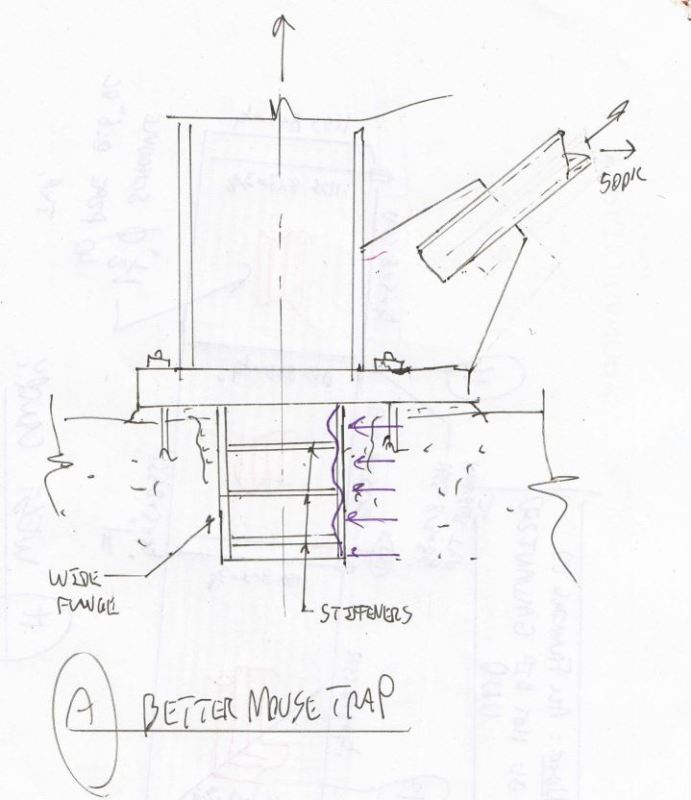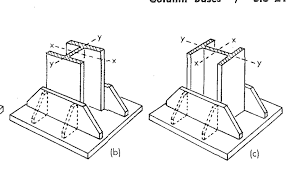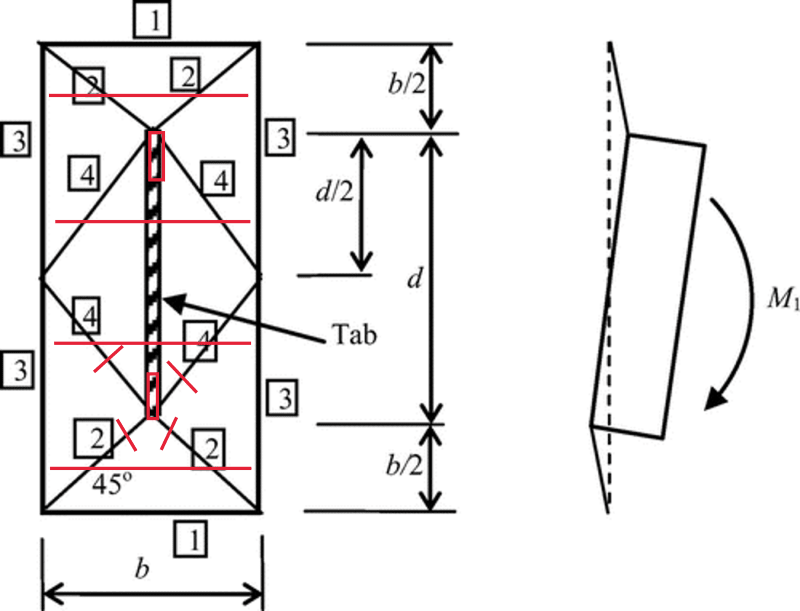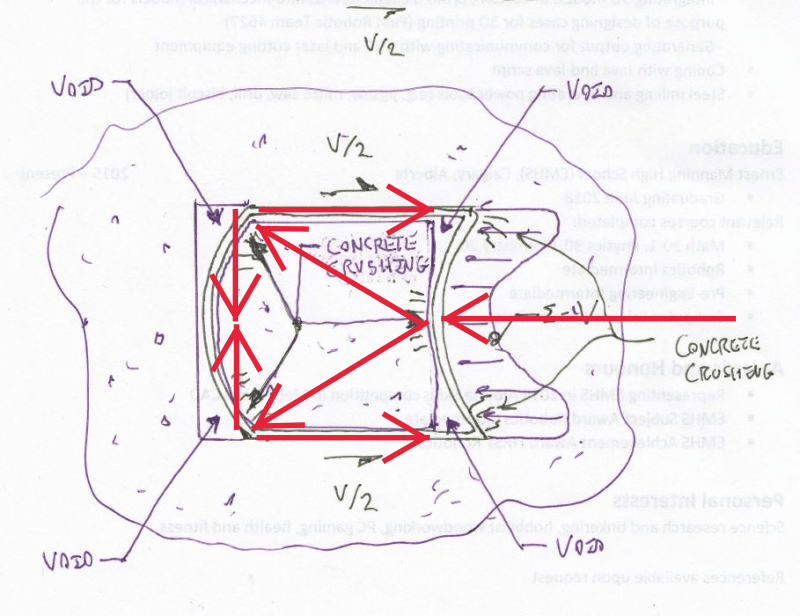Navigation
Install the app
How to install the app on iOS
Follow along with the video below to see how to install our site as a web app on your home screen.
Note: This feature may not be available in some browsers.
More options
Style variation
-
Congratulations MintJulep on being selected by the Eng-Tips community for having the most helpful posts in the forums last week. Way to Go!
You are using an out of date browser. It may not display this or other websites correctly.
You should upgrade or use an alternative browser.
You should upgrade or use an alternative browser.
HSS Shear Lugs
- Thread starter BAGW
- Start date
- Status
- Not open for further replies.
sail3 said:the face of the HSS has no significant stiffness compared to the sides
Yeah, that. You dun speak KootK goodish.
It occurs to me that there is a very good analogy for this situation: the mundane column base plate.
1) You get serious hot spots.
2) No way in hell they work without some local concrete crushing and redistribution.
3) We design them by preventing flexural plastification and this seems to work somehow.
Bones said:So my argument is not to worry about the HSS face bending because by then your shear lug is already gonna be having performance issues.
Okay. But this is very much like saying that we ought not worry about column base plate bending because by then we'd already be having grout/concrete performance issues. It's true but it's certainly not the conventional approach.
Bones said:If you use KootK's free body diagram and assume a narrow bearing width (maybe 2x wall thickness) at each the HSS walls parallel to the load, you could probably make a reasonable estimate of the bearing pressure on the surrounding grout and compare to an allowable.
I agree that this would be a valid approach. Interestingly, there's a column base plate design method for lightly loaded base plates that works pretty much the same way: Link.
My beef with this method for this application is that it's highly unlikely to work out in most practical scenarios. In my experience, folks in the wild are sizing these things for monster loads and need the entire HSS width to get it done. OP can correct me if I'm wrong but I believe that we're talking about an HSS 10x10 here and about 500 kip. No 2x thickness is going to move that kind of load unless the key is 4' long.
I like to debate structural engineering theory -- a lot. If I challenge you on something, know that I'm doing so because I respect your opinion enough to either change it or adopt it.
In the interest of being constructive, I think that something like this would be a much better choice for serious, woman sized loads. Again, not dissimilar from what Blodgett has us do for monster column base plates. Just sideways.


I like to debate structural engineering theory -- a lot. If I challenge you on something, know that I'm doing so because I respect your opinion enough to either change it or adopt it.


I like to debate structural engineering theory -- a lot. If I challenge you on something, know that I'm doing so because I respect your opinion enough to either change it or adopt it.
- Thread starter
- #23
@KootK Yeah the loads are pretty high. They are in range of 500-700kips. The tubes are close to 12''x12'' and are 2.5' long. So bearing capacity is 0.55 x 5ksi x 12 x 30 = 1000kips. Minimum width of tube I need to resist the load in bearing is 8'' assuming the bearing only on the front face. No way I can get 2 x thickness to get the shear lug to work in bearing.
Maybe I will design the lug for atleast this flexural behavior. I will use wl^2/12 and the HSS wall spanning 'D-2xt'. This should not be difficult to achieve.KootK said:If you're confident that you can get the grout in there you can, at best, split the load demand between the forward and rear HSS walls.
I'm curious now, will you put your work point at mid height of the lug?
I like to debate structural engineering theory -- a lot. If I challenge you on something, know that I'm doing so because I respect your opinion enough to either change it or adopt it.
I like to debate structural engineering theory -- a lot. If I challenge you on something, know that I'm doing so because I respect your opinion enough to either change it or adopt it.
Yea, I was thinking even while I typed that 2t was too conservative. Maybe there’s some testing out there that could shed some light on the performance of HSS shear lugs at ultimate strength levels. Maybe the stresses at the corners get happily redistributed or maybe the grout spalls away and the lug moves.
Back in the day I did some beta testing for a software company who was developing a FEM base plate design program. They used elastic springs for the concrete to calculate average stress under each element node. If I remember correctly, they would compare the peak bearing stress to the allowable bearing stress without any averaging or consideration of concrete crushing.
Back in the day I did some beta testing for a software company who was developing a FEM base plate design program. They used elastic springs for the concrete to calculate average stress under each element node. If I remember correctly, they would compare the peak bearing stress to the allowable bearing stress without any averaging or consideration of concrete crushing.
- Thread starter
- #26
. Center of column/Center of lug at top of baseplate. That is top of shear lug.Why do you ask?KootK said:will you put your work point at mid height of the lug?
. I couldnt find any. Tried looking through all resources.bones206 said:Yea, I was thinking even while I typed that 2t was too conservative. Maybe there’s some testing out there that could shed some light on the performance of HSS shear lugs at ultimate strength levels. Maybe the stresses at the corners get happily redistributed or maybe the grout spalls away and the lug moves.
bones said:If I remember correctly, they would compare the peak bearing stress to the allowable bearing stress without any averaging or consideration of concrete crushing.
I had a copy of RISA base back when it was standalone. I remember trying to model a base plate for a modestly loaded wide flange. For something that calc'd out at less than 3/4", I had to go to 2.5" in the FEM model to rid myself of the concrete bearing stress issues. Obviously, I retired the FEM for my common base plate designs.
BAGW said:Why do you ask?
This is a monster load and a long lug. With your work point at the base plate and your center of shear resistance 15" below that, you're dumping as much as 875 kip foot into the system at the joint. The question becomes where to put all that moment. If it goes into the base plate and anchor bolts then that obviously complicates the anchorage design. If it goes into the column, then you've got to deal with it there. You'd need something to the tune of a W14x132 to deal with that moment on an Mp basis alone. You'd also want to consider the impact of that moment on the column base rotation if that's where the moment goes. You don't want your lug rotating along with the column in such a way that your lug bearing stress distribution strays substantially from a uniform distribution.
I like to debate structural engineering theory -- a lot. If I challenge you on something, know that I'm doing so because I respect your opinion enough to either change it or adopt it.
- Thread starter
- #28
BAGW said:Dont we design the shear lug and the lug weld connection for that eccentricity? Assuming uniform bearing on the face of the lug and considering the moment arm from the center of the lug to attachment?
We do design for those things but they don't eliminate the moment imposed by the key on the joint that I mentioned in my previous post. They're just part of the load path that delivers the moment to the joint.
I like to debate structural engineering theory -- a lot. If I challenge you on something, know that I'm doing so because I respect your opinion enough to either change it or adopt it.
I believe the allowable bearing stress formula for shear lugs is somewhat liberal based on the vertical confinement pressure of the base plate above the grout. However, picture a base plate rotating and lifting up on one side, removing that confinement pressure on the tension side. Then consider that the shear lug is trying to do an Appendix D pryout maneuver on that same chunk of now unconfined concrete/grout. Add to that the high local bearing pressures at the "V/2" HSS walls trying to initiate a breakout cone...
I know we are really getting into the weeds answering a pretty innocuous question, but to me there are signs are pointing to brittle failure mode here. I think it's worth getting into the weeds over and it would definitely concern me more than the potential local yielding of the HSS wall.
I did take a few minutes to look over an experimental study this morning while my coffee was brewing. Inn this study they were using plates for shear lugs, but the results at large drifts seem to back up the general failure mode I'm describing:
I know we are really getting into the weeds answering a pretty innocuous question, but to me there are signs are pointing to brittle failure mode here. I think it's worth getting into the weeds over and it would definitely concern me more than the potential local yielding of the HSS wall.
I did take a few minutes to look over an experimental study this morning while my coffee was brewing. Inn this study they were using plates for shear lugs, but the results at large drifts seem to back up the general failure mode I'm describing:
pg 244 said:Examination of the specimens after testing revealed that none of the shear lugs experienced any
noticeable deformations, and that the welds attaching the shear lug to the base plate all remained
intact. At the smaller deflections (less than 2% story drift), data from the string pots on the
column bases reveals no significant lateral movement of the column base (less than 0.04 in),
indicating that the shear lugs did indeed provide adequate lateral resistance to movement.
It wasn’t until the larger deformations (greater than 4% drift) that the shear lug became
ineffective. As noted previously, it was discovered in post-test analyses that there was a
significant amount of damage to the grout underneath the base plate and surrounding the shear
lug. At these higher deflections, the grout was crushed, removing any bearing surface for the
shear lug, and the shear lug became ineffective. Large lateral movements were observed at the
base of the column at the later end of the test cycles as the lateral resistance of the base shifted
from the shear lug to the anchor bolts.
- Thread starter
- #32
BAGW said:can the gusset plate and weld between the gusset plate column and base plate be designed to take the moment due to eccentricity from shear instead of designing the column or the base plate for the eccentric shear moment?
I don't think so. If I understand your proposal correctly, the welds would transmit the moment to the column and/or the base plate an you're back to the same situation.
I like to debate structural engineering theory -- a lot. If I challenge you on something, know that I'm doing so because I respect your opinion enough to either change it or adopt it.
- Status
- Not open for further replies.
Similar threads
- Locked
- Question
- Replies
- 8
- Views
- 5K
- Replies
- 4
- Views
- 11K
- Replies
- 17
- Views
- 4K
- Replies
- 1
- Views
- 632
- Replies
- 4
- Views
- 2K


